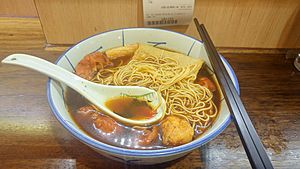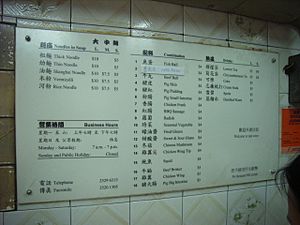Cart noodle facts for kids

Cart noodles with beef soup
|
|
| Type | Noodles |
|---|---|
| Course | Main course |
| Place of origin | Hong Kong and Macau |
| Serving temperature | Hot |
| Main ingredients | Flour, egg and depend on toppings |
| Cart noodle | |||||||||||||||
|---|---|---|---|---|---|---|---|---|---|---|---|---|---|---|---|
| Traditional Chinese | 車仔麵 | ||||||||||||||
| Simplified Chinese | 车仔面 | ||||||||||||||
| Cantonese Yale | Chējái mihn | ||||||||||||||
|
|||||||||||||||
| Alternative Chinese name | |||||||||||||||
| Traditional Chinese | 嗱喳麵 | ||||||||||||||
| Simplified Chinese | 嗱喳面 | ||||||||||||||
| Cantonese Yale | Láhjá mihn | ||||||||||||||
|
|||||||||||||||
Cart noodle (traditional Chinese: 車仔麵; simplified Chinese: 车仔面) is a super popular dish from Hong Kong and Macau. It became famous in the 1950s. Back then, street vendors sold these tasty noodles from small carts. They set up their carts on roadsides and in public housing areas. Even though many original street vendors are gone, cart noodles are still a big part of the local food culture.
Contents
History of Cart Noodles
How Cart Noodles Started
In the 1950s, many people moved to Hong Kong from mainland China. To make a living, some became hawkers. These hawkers sold food from carts they pushed through the streets. Some specialized in cooking noodles right there. They offered different toppings and styles for their noodle dishes.
The Original Carts
The old carts were often made of wood. They had metal basins inside to keep the food warm. In the past, you could get a lot of noodles for a very low price. This made them a popular meal for everyday citizens. Because they were so cheap, some people called them "filthy noodle" (嗱喳麵). This was due to concerns about hygiene. Over time, hygiene rules became stricter. This led to many street vendors disappearing.
Cart Noodle Today
A Lasting Legacy
Even though the old street carts are mostly gone, the idea of cart noodles lives on. You can still find them almost everywhere. They are very common in casual restaurants called eateries. The price of your cart noodle dish can change. It depends on what ingredients you pick. It also depends on where you buy them.
Modern Cart Noodles
Sometimes, cart noodles are even sold in fancier restaurants. This is because they are now seen as a cool, old-school food. These places might offer more expensive toppings. But the basic idea of choosing your own noodles and toppings remains the same.
Building Your Own Cart Noodle Bowl
Cart noodles are special because you get to create your own meal! You choose everything that goes into your bowl. This includes the type of noodles you want. You also pick your favorite soup broth. And, of course, you add all the toppings you like.
Popular Toppings
There are so many toppings to choose from! Here are some common ones you might find:
- Pig skin (豬皮)
- Curdled pig's blood (豬紅)
- Pig intestine (豬大腸)
- Pig oviduct (生腸)
- Red Chinese sausage (紅腸)
- Pork sausage
- Chicken wing (雞翼)
- Spam (餐肉)
- Omasum (牛百葉)
- Beef ball (牛丸)
- Beef offal
- Pork ball (豬肉丸)
- Fried fishball (炸魚蛋)
- Cuttlefish ball (墨魚丸)
- Fishcake
- Crab stick (蟹柳)
- Octopus
- Fried tofu
- Wonton (雲吞)
- Siu mai (燒賣)
- Green vegetables (蔬菜)
- Chinese radish (蘿蔔)
- Spinach
- Rehydrated shiitake mushroom (冬菇)
- Winter mushrooms
Noodle Choices
You can pick from many different types of noodles. Each one has a unique texture.
- Ho fan (河粉)
- Thick noodles (粗麪)
- Thin noodles (幼麪)
- Oil noodles (油麪)
- Rice noodles
- Yi mein (伊麪)
- Udon (烏冬)
Soup Flavors
The soup is a very important part of cart noodles. It often has a curry flavor. Some places might let you choose other soup flavors too.
See also
 In Spanish: Fideo de carro para niños
In Spanish: Fideo de carro para niños



